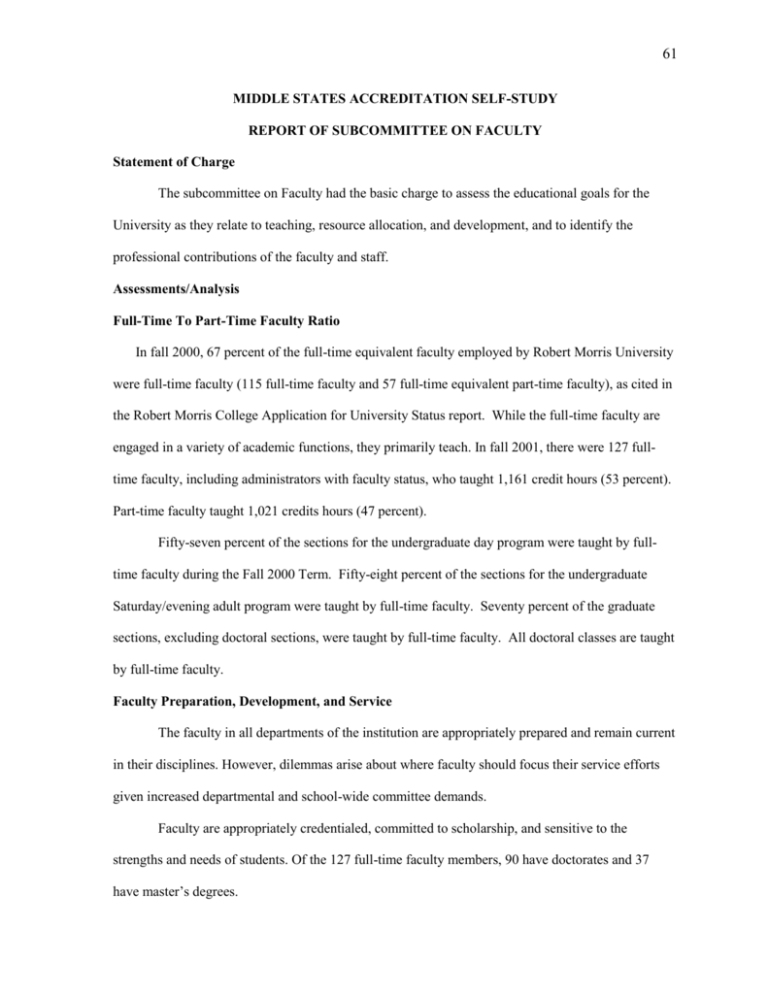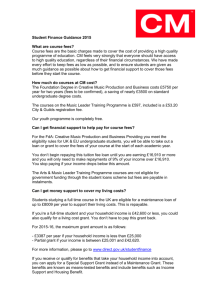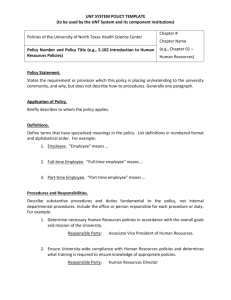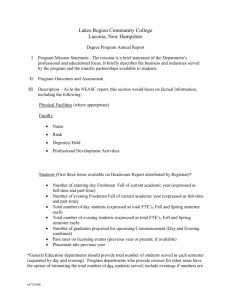Full-Time Faculty Spring 2002 Staff
advertisement

61 MIDDLE STATES ACCREDITATION SELF-STUDY REPORT OF SUBCOMMITTEE ON FACULTY Statement of Charge The subcommittee on Faculty had the basic charge to assess the educational goals for the University as they relate to teaching, resource allocation, and development, and to identify the professional contributions of the faculty and staff. Assessments/Analysis Full-Time To Part-Time Faculty Ratio In fall 2000, 67 percent of the full-time equivalent faculty employed by Robert Morris University were full-time faculty (115 full-time faculty and 57 full-time equivalent part-time faculty), as cited in the Robert Morris College Application for University Status report. While the full-time faculty are engaged in a variety of academic functions, they primarily teach. In fall 2001, there were 127 fulltime faculty, including administrators with faculty status, who taught 1,161 credit hours (53 percent). Part-time faculty taught 1,021 credits hours (47 percent). Fifty-seven percent of the sections for the undergraduate day program were taught by fulltime faculty during the Fall 2000 Term. Fifty-eight percent of the sections for the undergraduate Saturday/evening adult program were taught by full-time faculty. Seventy percent of the graduate sections, excluding doctoral sections, were taught by full-time faculty. All doctoral classes are taught by full-time faculty. Faculty Preparation, Development, and Service The faculty in all departments of the institution are appropriately prepared and remain current in their disciplines. However, dilemmas arise about where faculty should focus their service efforts given increased departmental and school-wide committee demands. Faculty are appropriately credentialed, committed to scholarship, and sensitive to the strengths and needs of students. Of the 127 full-time faculty members, 90 have doctorates and 37 have master’s degrees. 62 Under the Collective Bargaining Agreement, the University has a merit system for all faculty in the bargaining unit. The bargaining unit excludes administrators such as department heads and deans who hold faculty status. The merit system has been in place since the 1990 contract. Merit Awards in Teaching The percentage of faculty receiving merit or highest merit for teaching has remained remarkably consistent within a range of 93 percent-99 percent from 1994 to 2000; the three years beginning with 1998 have been 99 percent, 99 percent, and 98 percent, respectively. All bargainingunit faculty are evaluated for merit in teaching. Merit Awards in Scholarship Faculty have strong qualitative incentives to pursue scholarship such as professional standing, institutional accreditation, and personal achievement, and they have strong quantitative incentives such as merit pay and course release time for research. Since 1990 more faculty have become eligible for merit shares in scholarship while the amounts negotiated for them declined. In the 1993-1994 merit in scholarship was worth $418 per share and highest merit was worth $836. In the 1999-2000, merit was $261 per share and highest merit, $522. Since 1994, the percentage of faculty receiving merit or highest merit for scholarly and creative activities has ranged from 39 percent to 53 percent; in the three years since 1998, 47 percent, 53 percent, and 48 percent of eligible faculty have received some level of merit for scholarship. Approximately 50 percent of the bargaining-unit faculty apply for merit for their scholarly and creative activities. (In this category, unlike that of Teaching and Service, faculty may elect not to participate.) In a teaching-oriented institution, the increase of participation from 39 percent to nearly 50 percent from 1994-2000 reflects a significant change in the institution’s culture. Under the Collective Bargaining Agreement (Article XIV, Section D, p. 32) the University may from time to time grant sabbatical leave to employees for study, travel, research, publication, or other activities that will result in increased individual performance or produce academically or socially useful results. 63 Merit Awards in Service Merit awards for service to the University and the community are small, ranging from $126 to $178 from 1994-2000. Full-Time Faculty Teaching Loads Full-time faculty members are normally required to teach 24 credit hours or their equivalent per academic year (Collective Bargaining Agreement, 1999-2003, p. 39). For purposes of this provision, the following equivalencies apply: One (1) undergraduate level three (3) credit course = (3) credit hours; One (1) master’s level three (3) credit course = (3) credit hours; and One (1) doctoral level three (3) credit course = six (6) credit hours. Each faculty member receives a course release for every two master’s courses taught. Teaching one doctorate course is equivalent to teaching two undergraduate courses. Faculty members are responsible for up to six course preparations per year. Orientation for New Faculty Members The University provides an orientation program before the fall semester for new faculty members (full-time and part-time). In Fall 2001, new faculty members attended a series of orientation meetings in the first eight weeks of the academic year. Topics discussed include the mission of the University, academic governance, goal setting, review of student affairs, and general logistics issues. Also, members of the human resources department meet with new faculty to explain policies and benefits. Faculty Role in Program Development The faculty are significantly involved in devising and developing the institution’s academic, professional, research, and service programs within the framework of its educational mission and goals. For example, there is a Professional Development Committee that offers workshops for the faculty on a variety of topics. Also, there are graduate and undergraduate curriculum committees that review the programs and syllabi. The Graduate Curriculum Committee and Undergraduate 64 Curriculum Committee are recognized by the Collective Bargaining Agreement, 1999-2003 (pp. 56, 61). The Graduate Curriculum Committee comprises three full-time faculty members from each school offering graduate programs. Each school elects three full-time faculty members from among the graduate faculty of the school. The Graduate Curriculum Committee makes recommendations to the University on matters related to graduate programs such as standards for degrees, grading policies, admission criteria, class size, degree requirements, and applicants for the graduate faculty. The Undergraduate Curriculum Committee considers and advises the University about curriculum matters like course and program proposals. A formal procedure is in place for reviewing proposals for new programs and courses. Both school and departmental planning committees are active. Teaching as the Faculty’s Primary Responsibility The institution and the faculty accept teaching as the primary responsibility of faculty. In the Collective Bargaining Agreement, 50 percent of the merit pool is set aside for merit in teaching. A faculty member must first earn merit in teaching before becoming eligible for merit in Service or Scholarly Activity. Support of Faculty Scholarship and Development Through Release Time and Funding The agreement between the University and the RMC Federation of Teachers provides for a 3credit teaching load release per term for faculty to conduct research and scholarly writing and Sabbatical Leave for faculty activities that “will result in increased individual performance or produce academically or socially useful results.” A review of sabbatical and course reduction information reveals that of the 18 requests for sabbatical leave since 1995, 12 or 67 percent have been granted. Of the 15 requests for course load reductions since the Spring 2000 semester, 13 or 87 percent have been granted Robert Morris University supports faculty research and development by providing merit pay for scholarship, especially publishing and presenting at national academic conferences; teaching load reductions for research; travel funding for scholarly purposes, especially for conferences; tuition loan programs for completing doctoral studies; sabbaticals for study and scholarly writing. The University 65 also encourages faculty-student collaboration in applied undergraduate and graduate research projects. The University also supports the Faculty Development Committee, which analyzes faculty development needs and recommends methods of meeting them. The Communications Skills Program sponsors faculty development workshops to demonstrate strategies for adapting current research into pedagogy. The Division of Adult and Continuing Education sponsors faculty development workshops for technological applications of software and teaching online courses using andragogical principles. Each full-time faculty member is allotted a travel budget of approximately $840 per year for participation in professional conferences and workshops. In practice, because not all faculty travel, productive faculty receive more. The University may grant up to three one-year educational leaves to faculty members who are pursuing doctoral studies. Monitoring Program Change and Conditions of Employment The University has an effective system for monitoring changes in program requirements; needs of faculty for adequate and equitable procedures for conditions of employment; employment and tenure status, workload and compensation, and support services for faculty; and their participation in governance, Also, the University has an effective system for implementing changes in these areas. School deans and the faculty, through the Undergraduate and Graduate Curriculum Committees, monitor program changes and requirements (see “Faculty Role in Program Development” above). In addition, the Communications Skills Program Faculty Evaluation and Implementation Committee (FEIC) for CSP Courses I-V and especially Communications Skills Evaluation and Courses VI-IX Curriculum Committee effectively monitoring changes in the CSP program requirements. School Deans and the RMU Federation of Teachers monitor employment concerns and needs informally and formally. The terms and conditions of salaries, work, employment, benefits, and job security are governed by the Collective Bargaining Agreement, 1999-2003. Employment concerns 66 and needs are effectively voiced and monitored through the processes of the Collective Bargaining Agreement. Faculty Diversity The University recognizes the importance of having a diverse faculty deliver the curriculum. Therefore, the University continues to expand faculty diversity. Past efforts to recruit minority faculty have included advertising positions in minority-focused periodicals and offering recruiting incentives that allowed each academic department who recruited a minority faculty member to have an extra full-time position. The academic deans have been asked to revise recruiting plans to include specific activities for recruiting minority faculty. In recent years the University has successfully recruited several new minority faculty in the School of Engineering, Mathematics, and Science and the School of Communications and Information Systems. Criteria for the Appointment, Supervision, and Review of Part-Time Faculty The criteria for the appointment, supervision, and review of part-time faculty are comparable to those for full-time faculty. All faculty are recruited, hired, supervised and reviewed by department heads with the oversight of their deans. Part-time faculty must have at least a Master’s Degree and relevant experience. They are evaluated each term by class observations and through nationally normed student questionnaires. Many part-timers are mentored by veteran faculty members. For example, part-timers who teach communications-intensive courses meet with the faculty who have created the course plans to help maintain the standards of the Communications Skills Program. The Faculty Evaluation and Implementation Committee (FEIC) for CSP Courses I-V is a support group of all faculty who teach CO I-V. The FEIC engages in self-assessment faculty work, provides mentors and peer support, and offers workshops in teaching and evaluation methods. The department of management full-time faculty, as another example of mentoring, trains part-timers who teach the senior level Management Simulation course to use the simulation program. 67 Process for Nonrenewals of Full-Time Faculty The Collective Bargaining Agreement provides that a full-time faculty member hired after May 10, 1999, may not appeal nonrenewal of his or her teaching appointment up through the fifth year of employment unless the faculty member has received tenure, or its equivalent, at another institution of higher education. Then the period is reduced to three years. In the sixth year of employment, a faculty member may appeal nonrenewal of his or her teaching appointment in writing to a committee of the appropriate dean, the assistant vice president for administration and human resources, and the president of the Federation or their designees. The Committee shall issue its decision in writing. Thereafter, an employee is guaranteed reappointment unless he has: (1) failed to effectively perform the responsibilities of the position; or (2) failed to achieve the level of growth consistent with the growth of the discipline. Such failure to reappoint may be appealed through the grievance procedure. At the time of hire, the University has the right to establish a maximum of up to six years during which time a faculty member must achieve a specific level of academic achievement. A failure to reappoint a faculty member who does not attain the specific level of academic achievement within the prescribed time frame shall not be subject to appeal. Since 1992 only three faculty members have not been reappointed for failure to complete their doctoral studies. Approaches to Teaching and Activities to Enhance Teaching. RMU continues to use innovative and teaching practices based on sound theoretical principles and attuned to the needs of our students. Faculty are trained in appropriate theories and practices and are offered formal and informal workshops to help them adapt their courses to new pedagogies designed to help students grow in the knowledge, skills, and literacy that their discourse 68 communities demand. Notable approaches to teaching that are used and activities available to enhance teaching include the following: Writing Across the Business Disciplines (WABD): Since its inception in 1984 through a generous grant from the Buhl Foundation, RMU has supported the Writing Across the Business Disciplines (WABD), first, in conjunction with Buhl and later assuming full financial as well as academic and administrative responsibility for the program. From 1995 to 2000 WABD was an independent department of the University with its own director and budget. In 2000 it was merged with the Communications Skills Program, which is based on WABD course design principles. WABD is an extensive writing-to-learn Writing Across the Curriculum (WAC) program that operates through targeted, already-existing courses. WABD teaches faculty to use a structural approach to WAC in order to bring the best theory and practice into already existing targeted courses. More than 50 faculty have been trained in this structural writing-to-learn approach; more than 50 courses have been created that brings course goals together with material to be covered into language-to-learn activities that offer students a chance to better learn course subject. More than 10,000 students have been beneficiaries of this practice. WABD has been so successful at integrating language-to-learn activities into faculty course plans that the program captured a Department of Education FIPSE grant to teach our structural approach to Writing Across the Curriculum to six other schools across the United States: Babson College, Bryant College, Golden Gate University, Kent State University Regional Campuses, Mercyhurst College, and Southeastern University. Communications Skills Program (CSP): Since 1995 RMU has implemented an audiencefocused, nine-course, 27-hour Communications Skills Program (CSP). The CSP allows students extensive integrated practice in reading, writing, listening, and presenting, using appropriate technological support. The first five courses, taught by department of communications or CSP faculty, are sequenced according to level of sophistication in understanding audience. The last four 69 communication-intensive courses of the program, CSP VI-IX, are taught in the subject-areas departments in already existing, but re-designed courses. (See Curriculum Chapter.) In 1998 RMU won a Certificate of Excellence from the Hesburgh Foundation for a “faculty development program that enhances undergraduate teaching and student learning”. On-line Classes: Another example of University's efforts to provide a varied and flexible approach to teaching and learning is through on-line classes. RMU offers a number of seminars in pedagogy and technology that enhance faculty ability to effectively participate in our distancelearning program (See ACE Division, Curriculum Report). Pre-MBA courses also went online in the spring. The University has sponsored a series of workshops to prepare faculty who volunteer for Pre-MBA courses. (See On-line Courses Policy and see Curriculum Chapter.) Learning Communities: The University is experimenting with a "learning communities" approach to some first-year courses. This pilot project is commissioned by The Committee for Student Success, a committee that includes administrators, staff, and faculty (17 members), and aims to 1) improve student satisfaction; 2) ensure the likelihood of student success and; 3) retain more students. The pilot program entails developing, implementing, and evaluating a 9-week Freshman Seminar course linked by content and shared assignments to CO120 Communication Skills I and CI212 Computing and Software Essentials. The Freshman Seminar assists students in learning how to 1) set and attain realistic educational and career goals; 2) take advantage of campus resources, services and opportunities; 3) develop effective time management and study skills; 4) develop strategies to become socially responsible, serve the community, and develop professionally; and 5) interact with people of different cultures. (See exhibit titled "Learning Communities Pilot Project") Language-to-learn in Mathematics: The Mathematics Department is using innovative teaching practices, including language-to-learn activities, to reach students enrolled in QS099, a remedial algebra course. These students have a history of problems with mathematics. A department 70 faculty member wrote a booklet entitled “How to Study and Learn Mathematics” that helps students understand the locus of control is with them. Students are given specific instructions on what they should do to pass QS099 and asked to write a paper called “Math and Me” describing their history with mathematics and how they intended to incorporate at least one idea from the pamphlet into their studying for QS099. Students in the QS099 that used the language-to-learn strategies fared better than those in a section that did not, according to faculty analysis of test results that showed a significant decline in the number of N (No Pass) grades in the section that used the new methods. Participants’ attendance is better, their assignment completion rate is higher, and their subsequent exam grades continue to be better. Addison Wesley has awarded the faculty member who implemented the new methods a small grant to class test some new software and a textbook in QS099. Some Mathematics faculty are also experimenting and expanding voluntary free review sessions. Participation has grown in a year from a handful of students to more than 50 students. In the University’s new Engineering Program, faculty schedule regular help sessions for students. Help sessions are held once per day, and twice on Friday, and are open to any engineering student. In a session, students typically work in teams of about four per group. Following data collection students have about a week to do data analysis and submit written laboratory reports. The Information Systems Department is combining hands-on experience with computers and cognitive content in courses leading to the ability to take A+, Network+, and Microsoft Certified Professional exams. Collaborative Learning through Cohort Groups: The University’s doctoral program, leading to a Doctor of Science in Information Systems and Communications degree, merges an interdisciplinary education with practical, professional experience. This approach to collaborative learning is distinctive in a number of respects: It is designed for completion within three years; students matriculate within cohort groups; students participate in campus residencies with their cohort groups; students work closely with “field mentors” as well as their doctoral committees; and 71 coursework is offered in an executive education format to provide convenience and flexibility. (See Brochure for Prospective Students) Projection/Recommendations 1. For the 2001-2002 school year, Robert Morris University hired 17 full-time faculty. Although these hires improve the full-time/part-time ratio, the subcommittee recommends a target goal of 75 percent full-time faculty. 2. To assure continuity of quality education University-wide, RMU should explore both formal and informal modes for integrating new faculty, both part- and full-time, into RMU traditions of excellence in teaching. Currently, the University is holding a series of breakfast meetings for new faculty to familiarize them with the major initiatives and programs of the University. In addition, these modes may include mentoring by more experienced colleagues and increased opportunities to share teaching techniques among faculty. 3. The faculty union and the administration should establish a closer relationship by having more frequent meetings between union representatives and administration. 4. RMU should increase monetary incentives for scholarship, teaching, and service. 5. RMU should increase the scope and funding of the Professional Development Committee to facilitate and support interdisciplinary activities such as the development of interdisciplinary funding proposals, and it should offer forums for faculty members to present and discuss their research, intellectual enthusiasms and concerns, and teaching techniques. 72 Robert Morris University Tables on Faculty Diversity Full-Time Faculty Spring 2002 Staff - Totals Total full-time faculty by gender and race/ethnicity Administrators with faculty status Men* Nonresident Alien Black, Non-Hispanic American Indian/Alaska Native Asian/Pacific Islander Hispanic White, non-Hispanic Race/ethnicity unknown Women* Men* 1 1 25 19 Women* 1 2 1 65 6 6 Totals 69 26 21 Grand Total: 122 full-time faculty including administrators with faculty status *including librarians with faculty status Part-Time Faculty Fall 2001 Total part-time faculty by gender and race/ethnicity Faculty (instruction, research, public service) Nonresident Alien Black, Non-Hispanic American Indian/Alaska Native Asian/Pacific Islander Hispanic White, non-Hispanic Race/ethnicity unknown Totals Grand Total: Faculty (instruction, research, public service) 1 2 3 1 90 4 70 10 98 83 181 part-time faculty 73 IV. Exhibits a. Collective Bargaining Agreement, 1999-2003 b. Application for University Status Report c. On-line Course Policy d. Learning Communities Pilot Project e. Doctoral Program Brochure for Prospective Students f. Institutional Support of Research and Faculty Development: A Supplement to the Application for University Status g. Mission/Vision statements h. Merit Shares Scholarly Activity and Service, 1993-2000 i. Promotions in Faculty Rank j. Number of Faculty, by Category, who received Merit in 1991-2000 k. Sabbatical/Leave/Course Reduction Information





